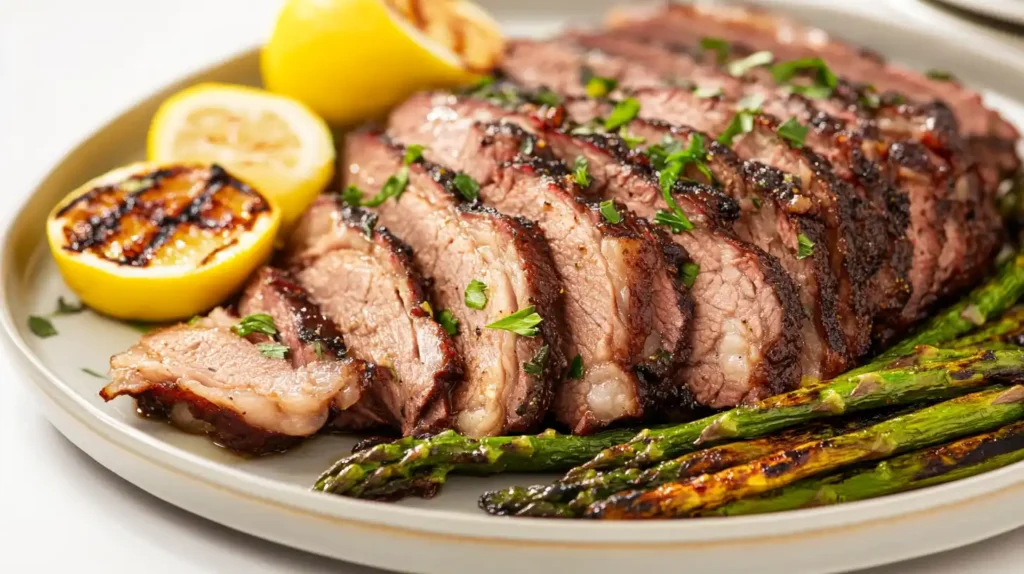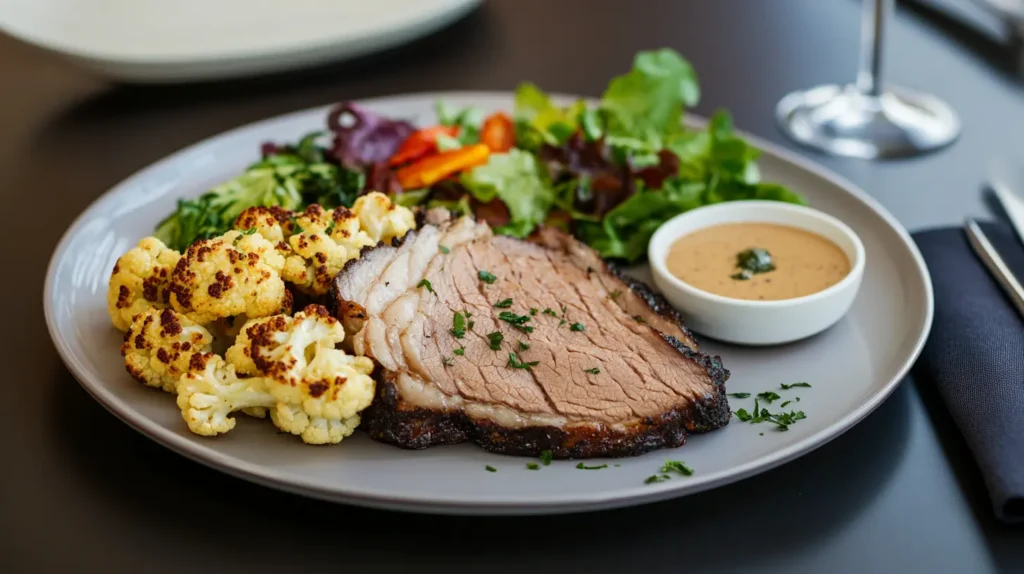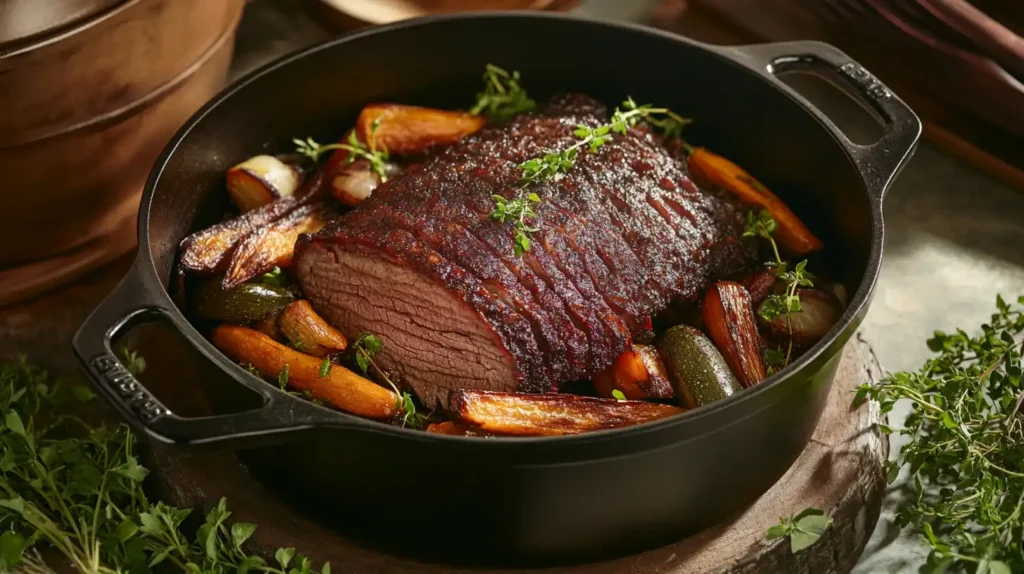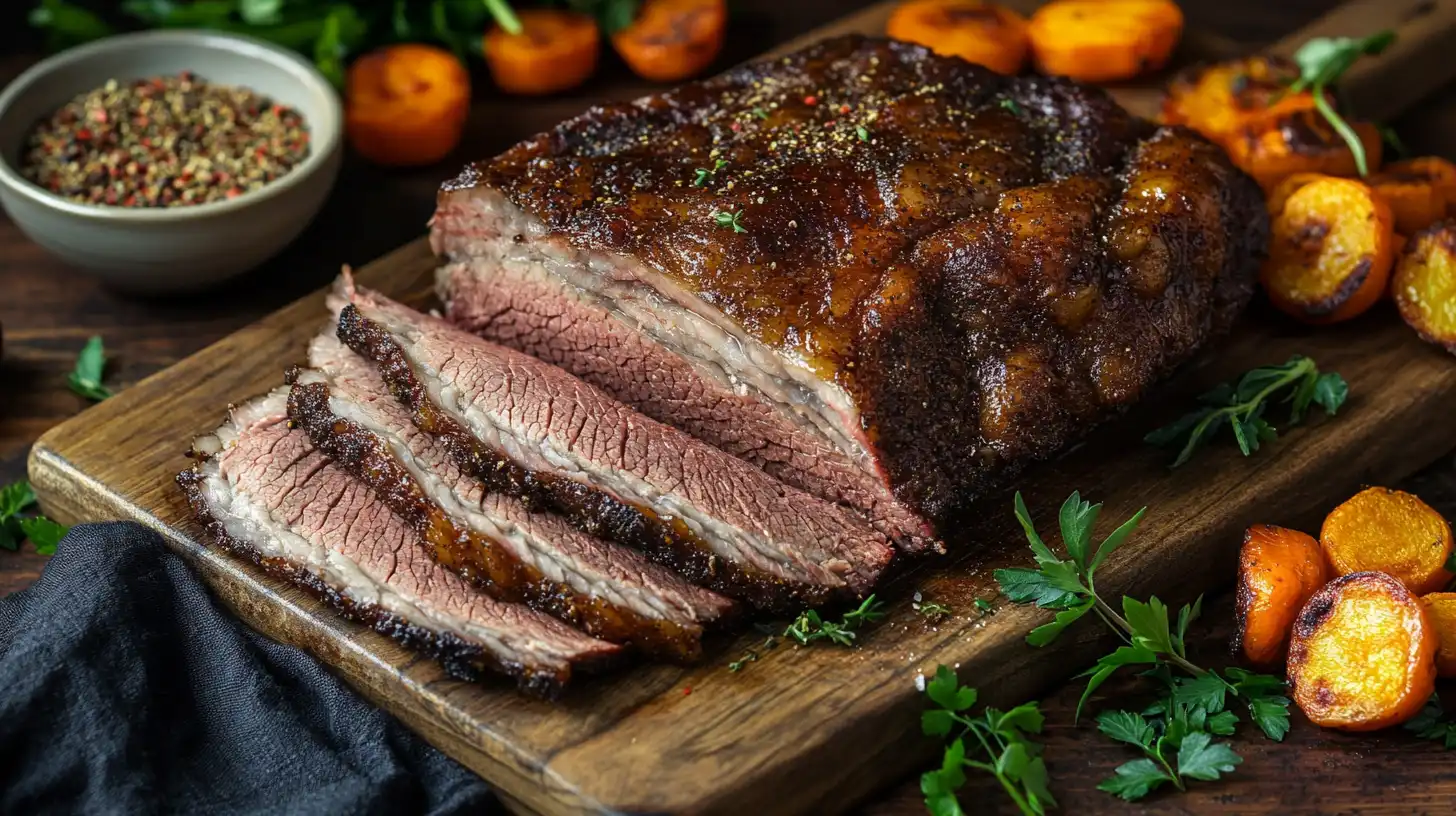Introduction
Is brisket healthy for you? This is a question many people ask when enjoying this flavorful cut of beef. Brisket is loved for its rich taste and tender texture, often served as a centerpiece at barbecues or in comforting homemade meals. But what about its nutritional value? Does it fit into a healthy lifestyle?
In this guide, we’ll explore whether brisket is nutritious, its health benefits, and how to make it a healthier choice. Whether you’re a brisket enthusiast or simply curious about its place in your diet, this article will provide the answers you need.
Nutritional Profile of Brisket: Is Brisket Nutritious?
Key Nutrients Found in Brisket
Brisket offers many essential nutrients that benefit your health. It provides high-quality protein, which helps build and repair muscles. In addition, brisket includes important vitamins and minerals like:
- Iron: This mineral supports red blood cell production and boosts energy levels.
- Vitamin B12: It helps your brain work properly, supports nerves, and gives you energy.
- Zinc: This nutrient strengthens your immune system and aids in healing wounds.
- Phosphorus: It plays a role in keeping bones strong and producing energy.

These nutrients make brisket a good choice for your diet when eaten in moderation and prepared with care.
Calories, Fats, and Proteins in Brisket
Brisket contains a mix of calories, fats, and proteins. Its nutritional value changes depending on how you prepare it, such as trimming the fat or choosing smoked or braised styles. For a typical 3-ounce (85-gram) serving of cooked brisket, you’ll get:
- Calories: Around 250–300 calories per serving.
- Protein: About 20–25 grams, making it a strong source of this vital nutrient.
- Fats: Roughly 18–20 grams, which include both saturated and unsaturated fats.
Trimmed brisket, with the extra fat removed, has fewer calories and less fat. Choosing leaner cuts allows you to enjoy brisket while keeping the meal lighter.
Health Benefits of Brisket: A Protein-Packed Choice
Brisket as a Source of High-Quality Protein
Protein is one of the building blocks of a healthy body, and brisket delivers plenty of it. A single serving of brisket provides around 20–25 grams of protein, which supports muscle growth, repair, and overall health. This makes it a great choice for those who are active, recovering from injuries, or looking to include more protein in their diet.
Additionally, brisket protein is considered complete. This means it contains all the essential amino acids your body needs but cannot produce on its own. Including brisket in your meals helps you meet your daily protein requirements in a tasty and satisfying way.
Essential Vitamins and Minerals in Brisket
Brisket isn’t just about protein—it’s also packed with vitamins and minerals that are crucial for your health. Some key nutrients include:
- Iron: Eating brisket can help prevent iron deficiency anemia by supporting healthy red blood cell production.
- Vitamin B12: This nutrient promotes proper brain function and helps maintain energy levels throughout the day.
- Zinc: Zinc from brisket boosts your immune system and helps your body heal faster when injured.
These nutrients are especially beneficial for people with higher nutritional needs, like pregnant women, athletes, or individuals recovering from illness.
The Role of Brisket in Low-Carb and Keto Diets

Brisket fits well into low-carb and keto diets because it is naturally low in carbohydrates. When prepared without sugary sauces or marinades, brisket becomes a protein-rich option that supports these dietary approaches. Many keto enthusiasts appreciate brisket for its fat content, which helps them meet their daily fat intake goals while staying in ketosis.
Pair brisket with low-carb sides like roasted vegetables or leafy greens to create a filling and nutritious meal that aligns with these dietary preferences.
Considerations for Eating Brisket: Healthier Ways to Enjoy It
Fat Content: What to Know
While brisket is a delicious source of protein, its fat content can be a concern for some individuals. Depending on the cut, brisket can contain between 18–20 grams of fat per serving, with a significant portion being saturated fat. Consuming too much saturated fat may increase cholesterol levels, which could impact heart health over time.
To enjoy brisket in a healthier way, opt for trimmed cuts or leaner portions to reduce the amount of fat. Additionally, limit heavy sauces and buttery toppings that can add unnecessary calories and fat.
Sodium Levels in Prepared Brisket
Prepared brisket, especially from restaurants or pre-packaged options, often contains high levels of sodium. Salt is commonly used in rubs, marinades, and sauces to enhance flavor, but too much sodium can contribute to high blood pressure or water retention.
If you’re cooking brisket at home, you can control the sodium by using lighter seasonings or experimenting with salt-free spice blends. This way, you’ll get all the flavor without the extra sodium.
Portion Size and Cooking Methods
Like any food, portion size plays a big role in how brisket fits into a healthy diet. Eating large portions frequently can add excess calories and fat to your meals. Sticking to a 3–4 ounce serving size allows you to enjoy brisket without overindulging.
The way brisket is cooked also matters. Slow cooking or smoking can retain the meat’s natural flavors and nutrients, while frying or adding heavy toppings may increase the calorie count significantly. Choosing healthier preparation methods ensures you get the most nutritional value from your brisket.
Making Brisket Healthier
Tips for Reducing Fat and Calories
One of the easiest ways to make brisket healthier is by trimming excess fat before cooking. Removing the outer layer of fat not only lowers the calorie count but also reduces the amount of saturated fat in the dish. Additionally, choosing leaner cuts like the flat cut, which has less marbling compared to the point cut, is a smart way to enjoy brisket without consuming too much fat. If you’re buying pre-packaged brisket, look for labels that say “trimmed” or “lean” for a healthier option.

Marinating brisket is another effective way to make it healthier. Using a marinade made with citrus juices, vinegar, herbs, and spices can tenderize the meat naturally and add vibrant flavors without the need for high-fat sauces or oils. Ingredients like garlic, onion, and smoked paprika provide bold, smoky undertones that enhance the brisket’s taste while keeping the calorie count low.
Another tip is to skim off fat after cooking, especially if you’re braising or slow-cooking the brisket. Let the juices settle, and then remove the layer of fat that rises to the top before serving. This simple step can significantly reduce the dish’s fat content while preserving its rich, savory flavor.
Choosing Healthier Cooking Techniques
The method you use to cook brisket plays a huge role in how healthy the final dish is. Healthier options include slow cooking, braising, or smoking, which allow the meat to cook in its natural juices without requiring extra fats or oils. These techniques bring out the brisket’s rich, deep flavors while maintaining a tender and moist texture. For example, smoking brisket over woods like apple or hickory can infuse the meat with natural flavors, reducing the need for high-calorie rubs or sauces.
Using an oven or slow cooker also offers more control over the cooking process. Braising brisket in a flavorful broth with vegetables like carrots, onions, and celery can create a hearty meal that’s packed with nutrients and lower in calories. You can experiment with broths made from low-sodium stocks or even wine for added flavor without unhealthy additives.
On the other hand, cooking methods like deep frying or slathering the brisket with sugary barbecue sauces can add unnecessary calories and fats. If you love barbecue sauces, consider making your own at home using natural sweeteners like honey or maple syrup, and reduce the amount of sugar and salt. A spice-heavy dry rub is another fantastic alternative to sugar-filled sauces and allows the natural flavors of the brisket to shine.
Pairing Brisket with Nutritious Sides
While brisket itself can be made healthier, the sides you serve alongside it are just as important. Instead of pairing your brisket with traditional, calorie-dense sides like creamy mashed potatoes, buttery biscuits, or macaroni and cheese, opt for nutrient-rich alternatives that complement the dish’s flavors while keeping the meal balanced. Here are a few ideas to try:
- Roasted Vegetables: Vegetables like Brussels sprouts, sweet potatoes, and carrots caramelize beautifully when roasted, adding a natural sweetness that pairs perfectly with the smoky, savory notes of brisket. Toss them with olive oil, salt, and pepper for a simple yet flavorful side.
- Fresh Salads: A crisp salad made with leafy greens, cucumbers, cherry tomatoes, and a light vinaigrette adds freshness and texture to your plate. For extra nutrients, include avocado slices or sprinkle seeds like sunflower or pumpkin seeds on top.
- Whole Grains: Sides like quinoa, farro, bulgur, or wild rice provide a hearty, fiber-rich addition to your meal. These grains help balance the richness of the brisket while keeping you full for longer.
- Steamed or Grilled Vegetables: Lightly steamed broccoli, asparagus, green beans, or zucchini are low-calorie, nutrient-packed options that pair beautifully with brisket. For added flavor, drizzle them with lemon juice or sprinkle with herbs.
- Legume-Based Sides: Lentil or chickpea salads can be a filling and protein-rich complement to brisket. Their earthy flavor and texture pair well with smoked or braised meats.
Finally, you can enhance the overall nutrition of your brisket meal by incorporating fermented or pickled sides. Pickles, sauerkraut, or kimchi add tangy flavors, probiotics, and a refreshing contrast to the richness of brisket, making the meal both satisfying and healthy.
By focusing on healthier cooking techniques and pairing brisket with nutrient-dense sides, you can create a meal that’s delicious, satisfying, and nourishing for your body.
Tips for Including Brisket in a Healthy Diet
1. Choose Lean Cuts
Opt for trimmed brisket or leaner cuts to reduce saturated fat. Pair your brisket with healthy sides like the Balthazar Beet Salad Recipe for a balanced meal.
2. Mind Your Portions
Moderation is key when enjoying brisket. Serving smaller portions alongside nutrient-dense sides can help maintain a healthy diet. For festive ideas, explore options in Gluten-Free Thanksgiving.
3. Experiment with Cooking Methods
Methods like smoking, slow cooking, or braising can enhance the flavor of brisket without adding excessive calories. Browse Smoker Recipes for new ways to prepare this delicious cut.
Frequently Asked Questions
Is Brisket Good for Weight Loss?
Brisket can fit into a weight loss plan when eaten in moderation and cooked in a healthy way. It is high in protein, which helps you feel full and supports muscle growth. To keep it lighter, choose lean cuts, trim the fat, and skip calorie-heavy sauces. Pair brisket with vegetables or whole grains to make a balanced and filling meal.
Can Brisket Be Part of a Heart-Healthy Diet?
Brisket can be enjoyed as part of a heart-friendly diet if you choose leaner cuts and avoid eating too much of it. The fat in brisket, especially saturated fat, can raise cholesterol levels if eaten often. To make brisket healthier, trim the fat, cook it with little salt, and skip sugary sauces. Pairing brisket with vegetables or whole grains is a great way to balance the meal.
How Does Smoked Brisket Compare to Other Cuts of Beef?
Smoked brisket is full of flavor because of its marbling and cooking process. However, it has more fat than leaner cuts like sirloin or tenderloin. For example, a 3-ounce serving of brisket has about 18–20 grams of fat, while sirloin has about 8 grams. Despite its fat, brisket is satisfying and a good choice for special meals. By trimming the fat and eating smaller portions, you can enjoy smoked brisket while staying healthy.
Is Brisket Suitable for Keto or Low-Carb Diets?
Yes, brisket is a great choice for keto and low-carb diets. It is low in carbs and high in protein and fat, making it perfect for these eating plans. To keep it keto-friendly, avoid sugary sauces and marinades. Use dry rubs or keto-friendly sauces instead. Pair brisket with low-carb sides like cauliflower mash or roasted vegetables for a tasty and filling meal.
What’s the Healthiest Way to Cook Brisket?
The healthiest way to cook brisket is by slow cooking, braising, or smoking it without adding extra fats. These methods keep the meat tender and flavorful without needing a lot of oils or butter. Trimming the fat before or after cooking makes brisket even healthier. Spice rubs or homemade sauces with little sugar and salt are great for adding flavor without extra calories. Pair brisket with healthy sides like salads or steamed vegetables for a balanced meal.
Conclusion
Brisket can absolutely be part of a healthy and balanced diet when prepared thoughtfully and enjoyed in moderation. This flavorful cut of beef is a great source of protein, vitamins, and minerals that support overall health. By choosing leaner cuts, trimming the fat, and using healthier cooking methods like smoking, braising, or slow cooking, you can make brisket a nutritious and satisfying option for your meals.
Additionally, pairing brisket with nutrient-dense sides like roasted vegetables, whole grains, or fresh salads enhances the overall nutritional value of your meal. Whether you’re following a low-carb or keto diet, looking for a protein-rich dish, or simply enjoying brisket at your next barbecue, there are plenty of ways to make it a healthier choice.
As with any food, portion control and balance are key. Enjoy brisket as an occasional treat or incorporate it into your weekly menu in a mindful way. With the tips and ideas shared in this guide, you can savor the rich, smoky flavors of brisket while staying aligned with your health goals. Happy cooking!

